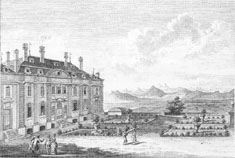

Dumas describes his visit to Ferney in 1832 in the chapter, "Lyons to Geneva", of his Travels in Switzerland.
The avenues around Geneva are delightful; at any time of the day carriages are ready to take the traveller anywhere his curiosity or fancy may lead him. When we had toured the town, we jumped into a caleche and asked to be conveyed to Ferney, which we reached two hours later.
The first thing one notices, just before entering the castle there, is a little chapel on which is an inscription, a work of art in itself, consisting of three words only: DEO EREXIT VOLTAIRE. It had been built with the object of proving to the whole world that the differences between the Creator and his Creation had been healed, and that a reconciliation had been effected between Voltaire and the Almighty. The world at large received the news with satisfaction, but strongly suspected that Voltaire had made the first advances. We passed through a garden, and mounting a flight of three steps, entered an antechamber wherein the pilgrims who come to worship at the shrine of irreligion usually foregather, just in front of the sanctuary proper. A concierge solemnly avers that nothing has been altered in the furnishings of the place, and that the room is just as Voltaire himself used it. This preamble rarely fails in its effect; those simple words have been known to reduce subscribers to Le Constitutionnel to tears.
Nothing is more phenomenal than the aplomb of the concierge charged with the duty of showing visitors over the place. Having entered as a child into the service of the Great Man, he possesses a repertoire of anecdotes which he relates so effectively as to delight the souls of the pilgrims who listen to him. When we set foot in the bedroom we saw an entire family ranged round him, breathing in every word he let fall, and the admiration they held for the philosopher was extended in almost to the same degree to the man who had polished his shoes and powdered his periwig. It was a scene almost impossible to describe. Every time the concierge pronounced, in a manner peculiar to himself, the sacred words "M. Arouet de Voltaire," he raised his hand to his hat, and all those surrounding him, who would not, perhaps, have done the same before Christ, religiously imitated this gesture of respect.
Ten minutes later it was our turn to receive instruction. The family paid up and departed, and we received the undivided attention of the cicerone. He shepherded us into a rather fine garden from whence the philosopher had had a marvellous view; we passed through a covered alley where Voltaire had written "his magnificent tragedy of Irene," and leaving us suddenly, he approached a tree, and cutting a shaving from it with a pruning knife, gave it to me. I put it to my nose and tongue in turn, thinking it was perhaps some strange wood that had a special smell or taste. No such thing; it was a fragment from a tree planted by M. Arouet de Voltaire himself, and it is customary for each visitor to be given a piece of it. This miraculous tree bade fair to die from an accident it had sustained about three months back; some sacrilegious person forced his way one night into the park and cut away three or four square feet of the sacred bark.
"No doubt some fanatic, or worshipper of la Henriade?" I remarked to our cicerone.
"No, monsieur," he replied. "It was probably some enterprising dealer who had been commissioned by a traveller from abroad--".
Stupendo!
On leaving the garden, our concierge led us to his own quarters. He wanted to show us Voltaire's walking-stick which he had religiously preserved since his master's death, and which he finally suggested we might buy for the price of one louis, the difficulties of the times forcing him to part with the precious relic. I told him that the price was too high, and moreover that I had known a subscriber to the Touquet edition of Voltaire's works to whom he had sold the identical memento eight years ago for the sum of twenty francs.
We re-entered our conveyance and took our way to the chateau of Madame de Stael, at Coppet.

View of the château from the garden, ca. 1780, by Michel-Vincent Brandoin